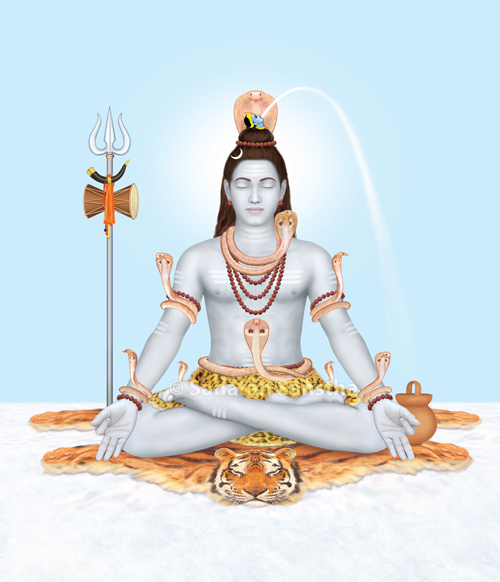Mahashivaratra (18th February)

|
Worshipping Deity Shiva
Method of receiving Deity Shiva’s grace
On the day of Mahashivaratra, the devotees of Deity Shiva worship Him with a lot of faith. Worshipping Deity Shiva by understanding the underlying science enhances the bhav (Spiritual emotion) and devotion of the devotee and he benefits increasingly. The worship of Deity Shiva includes various activities, from the physical darshan in a Shiva temple to performing His puja.
Deity Shiva who is everyone’s Deity of worship and is benevolent to all
1. Mahadev : Deity of Deities, the mighty Deity.
2. Shankar : Shankar is benevolent Deity of all.
3. One who manifests in various ways and forms is also the Family Deity of most families.
4. He is a highly awakened Deity, who is the propounder of Yogashastra, archery and 64 Art-forms, who is a family man like us all, who answers a devotee’s call immediately, is simultaneously hot-tempered but very kind, who always leads from the front and yet prefers solitude, who is found in maximum number of temples.
5. Right from the beginning, many Paths of worship and devotion have been founded through Deity Shiva’s inspiration and knowledge.
Deity Shiva’s distinctiveness
1. Ganga
A. ‘गमयति भगवत्पदमिति गङ्गा ।’, that is, ‘गङ्गा’ – the one who elevates (the bathing embodied soul) to the state of God, is Ganga.
B. ‘गम्यते प्राप्यते मोक्षार्थिभिरिति गङ्गा । (According to Shabdakalpadrum), meaning, the one to whom those desirous of Liberation turn to, is Ganga.
The origin of River Ganga is at Gangotri in the Himalayas and meets the Bay of Bengal through the medium of many of its tributaries. The River Ganga has a small percentage of the subtle Principle of the spiritual Ganga; hence, however impure it might become due to pollution of its water, it will always remain Holy. When compared with water from anywhere else in the world, water of Ganga is always Holy. This has been experienced by not only those who can perceive the subtle dimension but also scientists.
2. Moon : Deity Shiva adorns the Chandra (Moon) on His forehead. Chandrama is a stage which has the combined existence of qualities of affection, mercy and maternal love.
3. Third eye :
A. Deity Shiva’s left eye is considered to be His first eye, the right eye is the second, and the upper one, which is vertical and in the subtle form, just above the midpoint of the eyebrows is considered to be His third eye.
The upper eye represents the combined energy of both – the right eye and the left eye. It is also the greatest seat of extrasensory energy. This itself has been named Jyotirmath, Vyaspeetha, etc.
B. Deity Shiva’s third eye represents Tejtattva (Absolute Fire Principle). In Deity Shiva’s picture too, the shape of His third eye resembles a flame.
4. The Naga (Serpent) is also considered to be Deity Shiva’s weapon. The nine serpents in the Universe are also called ‘Navanarayan’. The Navanathas have originated from these nine serpents. Kartikeya, Jotiba, Ravalanatha and Sabbu are Deities in the form of serpents.
5. Bhasma : Deity Shiva has applied bhasma all over His body. Bhasma is also referred to as ‘Shiva’s semen’.
6. Rudraksha : Deity Shiva adorns chains of rudraksha beads around the knotted hair on His head and around His neck, arms, wrists and waist.
7. Vyaghrambar : The tiger (denoting the Raja and Tama components) is a symbol of cruelty. Deity Shiva killed such a tiger (The Raja and Tama) and made a vyaghrambar (Seat) from its skin.
(Ref.: Sanatan’s Text – ‘Spiritual science underlying the worship of Deity Shiva)
How should bhasma be applied ?Chapter 29 of Shri Gurucharitra says that bhasma should be placed on the palm while chanting mantras such as Sadyojat. Bhasma should be made sacred with mantras such as Agniriti, etc. || 200 || Uttering mantras such as Manastoke, bhasma should be rubbed between the thumb and the forefinger. With mantras such as Tryambak, it should be applied to the forehead. || 201 || Chanting the Tryayusha mantra, it should be applied to the forehead and arms. While chanting the same mantras, bhasma should be applied to different parts of the body. || 202 || One who does not know any mantra should apply it with pure bhav. This will have tremendous effects. |

To get maximum benefit of the Shiva Principle, we should also chant ‘Om Namaha Shivaya I’ as much as possible !